Important oceanographic data from Atlantic Ocean currents in the US Gulf of Mexico has been gathered fully remotely, thanks to Sonardyne technology and an uncrewed surface vehicle (USV) supplied by SeaTrac Systems.
A number of Sonardyne Origin 65 acoustic Doppler current profilers (ADCPs) and Current Pressure Inverted Echo Sounders (CPIES) are positioned on the seabed in the Gulf of Mexico gathering long term data on the Loop Current System (LCS).
Understanding the LCS is important for oceanographers as it has a wide-reaching impact on many areas including the disruption of subsea operations, hurricane intensity and changes to nutrient and food cycles important to marine life. However, sending manned vessels offshore to gather this LCS data incurs risk to crews and high operational costs, as well as generating greenhouse gas emissions.
SeaTrac recently launched its SP-48 USV from the Louisiana Universities Marine Consortium (LUMCON) in Cocodrie, LA, and remotely piloted it 580 nautical miles with a Sonardyne HPT 7000L transceiver onboard to acoustically gather the data from the ADCPs and CPIES.
The use of the solar and battery-powered USV reduced the environmental impact and cost of sending a crewed vessel for the mission whilst allowing for 24hr operations, with no manual intervention or personnel onboard.
Aidan Thorn, Business Development Manager for Marine Robotics at Sonardyne, says, “The use of a fully solar powered USV for a data gathering operation of this scale is a key moment in marine robotics. The Gulf of Mexico presents some of the most challenging ocean currents for any vessel, not-least an uncrewed one.
“One of the key reasons SeaTrac was chosen to partner with us on this project was their willingness to rise to the challenge and we are delighted with the results. USVs are a great platforms for collecting data from our seabed nodes and profilers through the integration of our acoustic communication technologies. We look forward to continued work with SeaTrac on this project and hopefully many others.”
Three further sets of data will be gathered over the next 18 months using the same uncrewed methods before the project completes.
Hobie Boeschenstein, Director of Operations and Business Development, at SeaTrac said: “We’re delighted to be working with Sonardyne on this project. Our SP-48 USV provides a complete system for maritime observation, data collection and reconnaissance.
“Powered by the sun with high-reserve batteries, it can operate in both near-shore and offshore environments through varying weather and sea conditions, as this mission has demonstrated. It can undertake missions lasting from several hours to several months and is designed to support a wide range of customer payloads. Sonardyne’s technology and company ethos is a great fit for ours and we look forward to supporting them in many future missions.”
Our summer had a boost of fresh ideas and enthusiasm this year with the arrival of five new engineering interns. The eclectic mix of PhD, degree and A-level students joined us at our Blackbushe headquarters in July. They worked alongside our staff for eight weeks, developing tools, methods and instruments for use in marine science and technology.
Their projects explored a diverse range of topics, including novel sensing technologies, calibration methods, data mining, subsea communications and statistical methods for analysing large volumes of data. Each student contributed to the design of their project and brought some impressive innovations to the company.
Week seven of the programme was held at our test facility in Plymouth, where they were given access to our local staff, offices and support vessels. All students participated in the deployment and recovery of their projects from our trial’s vessel, giving them valuable experience of using marine technology in a real-world scenario and leaving them with lots of data to analyse!

Sonardyne summer students, L-R: Matt, Poppy, Nairn, Dan and Chloe
The programme culminated in week eight, with each student delivering a 20-minute presentation to the Engineering department and a written report of their work. All five students performed fantastically well and impressed everyone with their hard work, intelligence and ideas – while also bringing lots of fun to Sonardyne! We wish them all the very best with their onward studies.
We are committed to supporting education and academia, including the sponsorship of PhD research students and summer internships, and working closely with local colleges for aspiring marine scientists and engineers. See our careers page for more information on these and other opportunities.
Supporting education and academia plays an important part in our business at Sonardyne. In this first blog of our series exploring how we do this, we look at how our technology is being used to research environmental monitoring techniques for offshore renewable energy. But first, a bit more about our involvement with education.
At a local level, we support local colleges in many of their engineering-based programmes. This has included a significant donation to Alton College enabling them to complete their engineering and design technology building, named the Sonardyne Centre, in 2013. We also employ several apprentices from Alton and other surrounding colleges across all areas of our operations. More can be found out about some of our current apprentices here.
In Higher Education we have degree programme apprentices, supply technology for ocean research operations, work with academics on research papers and projects and sponsor PhD students undertaking marine technology related research.
One area attracting a lot of research interest is Offshore Renewable Energy (ORE). As countries across the globe search for cleaner, greener, energy alternatives many are turning to offshore wind farms for their power. With the growth of offshore wind farms comes the need to understand their impact on the marine environment. Therefore, research is crucial as ORE projects, such as tidal-stream and offshore wind energy expand in scale and complexity. Accurate and robust environmental data is needed for commercial and regulatory decision-making, from initial site characterisation to environmental impact assessments and ongoing monitoring post-implementation.
We sponsor research student Chloe Turner-Dockery, studying at the University of Highlands and Islands, Thurso, Scotland, on her PhD programme: “Validating next-generation biophysical and metocean monitoring techniques for offshore renewable energy.”
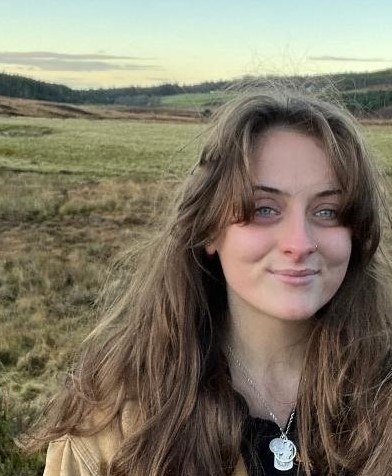
PhD student Chloe Turner-Dockery
Her three and a half year research programme will develop next generation monitoring techniques by integrating ecological and oceanographic data at fine spatial and temporal scales. These techniques will use hydroacoustic instruments, including echosounders and Acoustic Doppler Current Profilers (ADCPs), to provide comprehensive, non-invasive environmental monitoring.
The aim is to create cost-effective and risk-reducing methods for ORE monitoring by using sensors and platforms capable of collecting comprehensive data. The project is funded by the ETP Energy Industry Doctorate Programme via the Scottish Government, co-funded by UHI and Sonardyne, and co-supervised by the University of Aberdeen.
One of Chloe’s PhD supervisors is our ADCP group manager Tom Culverhouse, and our Origin ADCPs form a key part of her research toolkit. Her PhD programme covers three main areas:
Hydroacoustic Data Processing: This will develop methods to process ADCP and echosounder data for applications like fish school detection and assessing their effectiveness against traditional methods of detection.
Real-time Data Processing: Using existing data, and data collected during field trials, Chloe will work on enabling real-time decision-making capabilities on the devices, which can adapt sampling regimes and trigger other sensors during critical biophysical events.
Co-collection of Biophysical Data: This research will demonstrate the combined collection of biophysical data to monitor changes in biomass over time and depth, optimizing array-scale ORE monitoring. This will involve trials and collaborations with ongoing projects and at-sea testing.
Chloe explains; “By developing advanced monitoring and processing techniques, my aim is to enable the next step in uncovering the impact and potential disturbances caused by large scale arrays. This research will provide a more comprehensive understanding of how ORE developments interact with marine ecosystems, helping to quantify their impact. Ultimately, this will inform better decision-making and policy development, ensuring the sustainable expansion of ORE projects.”
Having started in February 2024, Chloe is at the early stages of the programme which follows her Undergraduate and Masters studies in Marine Biology but has already had experience of equipment trials using Origin 600. Practical experience as well as theoretical knowledge is vitally important for the advancement of marine technology as Tom Culverhouse explains:
“At Sonardyne we are fortunate to be working with institutes such as the University of Highlands and Islands (UHI) and the University of Aberdeen along with the world‑class graduate students they attract, like Chloe. UHI are a world‑leader in the impact on the natural environment of anthropogenic structures used to enable ORE. This thriving field provides a theoretical framework that is constantly and necessarily challenged by experimental field measurements. By engaging in this cutting‑edge research, Sonardyne can help drive the next‑generation of instrumentation to support ORE now and into a sustainable future.”
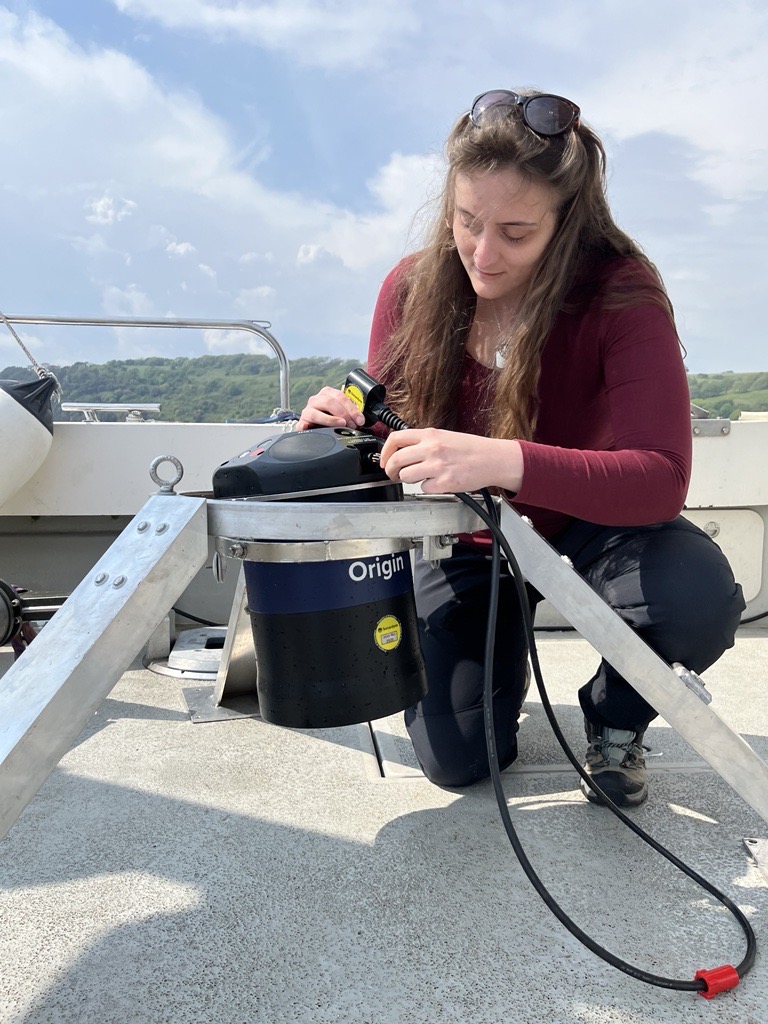
Chloe’s research involves a lot of hands-on experience using the latest ADCP technology.
Chloe also appreciates the benefit of access to the technology in support of her research. “Sonardyne’s support is fundamental to the success of my PhD project. Their technology and resources provide the necessary tools and platforms for advanced environmental monitoring techniques. Without their contribution, this research would not be possible. Their partnership not only facilitates access to essential equipment and data but also offers invaluable expertise and collaboration opportunities.” She adds; “My area of study has previously been focused on the biological aspects, so bringing together the physical side, as well as the technology for monitoring is very exciting to me. This allows me to broaden my understanding of the aspects involved in remote sensing and monitoring.”
As the offshore renewable energy market expands, we are proud to be able to provide the technology, expertise and support for the advancement of both academic research and industry operations.
We also sponsor other PhD students and work closely with several academic institutions in the UK and the USA. We’ll be bringing you more information about them on our website and social media soon.
In our previous navigation series blog, we talked about the value of a tightly calibrated hybrid navigation system. In this blog we focus on the Doppler Velocity Log (DVL), why aperture size is important, and the crucial role it plays in the hybrid navigation system.
Subsea autonomy relies on selecting the best performing instruments in the most optimal form factor available. As a manufacturer of navigation solutions (SPRINT-Nav) Sonardyne also design and manufacture the Syrinx range of Doppler Velocity Logs. Every time Sonardyne design an instrument or system, we start with a user problem we can solve, or a technology we want to bring to market to solve a possible future problem.
In this example we’ll focus on how we specify our DVLs, before looking at how they are used in our SPRINT-Nav products. We go back to first principles to determine the optimum DVL characteristics for the intended use case. Here we introduce one of the most visible characteristics of Sonardyne DVLs, their aperture and how it affects performance and usability.
We often talk about the importance of Size, Weight and Power (SWaP) in marine autonomous system payloads. When it comes to DVLs however, we also have to think about optimising them for performance within the SPRINT-Nav unit. This is two-fold, having the correct form factor to optimise DVL precision but also having tight integration utilising low level data directly from the DVL into the hybrid solution.
The key reason SPRINT-Navs are the shape they are is that for optimal performance we maximise the surface area for the DVL in our design, to maximise performance. The physics dictates that SPRINT-Nav products have the best form factor to optimise performance in the market and the importance of the DVL to that is explained below.
How does a DVL work?
DVLs work on the basis of transmission of an acoustic signal using a piezo electric transducer and using the same transducer to receive the “echo” return from the seabed. The difference in frequency of this return is crucially used to calculate the velocity, the timing of the return is used to compute the altitude of the unit relative to the seabed.
How do you design a DVL?
When designing a DVL the key parameters that affect the performance, always trading precision for altitude of the unit, are:
- Frequency of the acoustic signal
- Acoustic energy
- Angle of the transducer
- Size of the transducer
Our first consideration is frequency as you cannot judge a DVL by the size of the transducer unless the frequency is constant. See below for an example of the beam width of a piston transducer of 30mm and 54mm diameter.

Figure 1: Difference in beam width for a fixed size transducer at 500 kHz and 1 MHz frequencies
A narrower beam width equals a tighter doppler spread which drives an increase in precision of the instrument. Furthermore, as the beam gets narrower the more directivity gain you get, i.e. the effective source level is larger. Sonardyne manufacture 400, 500 and 600 kHz DVL’s which are optimised for precision and altitude. Other systems offer higher altitude through lower frequency DVLs but this is a trade-off between the precision of the DVL required when at operational altitude and the maximum altitude requirement.
It might be tempting to opt for the highest frequency instrument possible to maximise precision if operational range is not a consideration. However, as the operational range of UUVs extends, the ability to maximise DVL altitude whilst maintaining DVL precision – and thus navigation – performance is key.
The precision decreases as the beam width grows, this is due to larger differences between the lower edge of the beam and upper edge of the beam. Further, there will be larger differences between lower and upper edge of the beam as velocity increases.

Figure 2: How beam width affects doppler measurement
In essence:
- Doppler shift from lower beam = velocity * cos (angle of transducer + beam width)
- Doppler shift from upper beam = velocity * cos (angle of transducer – beam width)
If the beam width was zero (only possible theoretically) then there would be no doppler spread, or the precision error would be zero. As the beam grows the error increases and is also proportional to the velocity of the instrument, hence why precision standard deviation gets bigger at higher velocities.
In summary, for a fixed frequency of 500 kHz and fixed acoustic power of 10 Watts and same Janus angle on the instrument, these are the theoretical differences the size of DVL aperture alone makes to DVL performance.
| 30mm Aperture DVL transducer | 54mm Aperture DVL transducer | |
| Frequency | 500kHz | 500kHz |
| Beam width | 5.8° | 3.3° |
| Precision | 0.69 cm/s @ 1 m/s1.38 cm/s @ 2m/s | 0.39 cm/s @ 1 m/s0.79 cm/s @ 2 m/s |
| Source level | 214 dB | 219 dB |
| Expected altitude of the instrument | 195 m | 210 m |
Conclusion: So, what does this mean for navigation?
For accurate navigation, understanding of the precision of a DVL is essential. Precise DVL provides a robust long-term measure of velocity and when combined with accurate sound velocity will lead to better navigation.
Having a sensor with larger altitude range will decrease the amount of time the UUV will spend in depth constrained free inertial navigation, thus reducing the rate of position error growth. This is increasingly important in subsea robotic operations as we see remote operations expand where UUVs may be travelling over larger distances, away from ships and shore so traditional aiding sources like USBL will be less available. The physics speaks for itself and selecting an instrument with the maximum aperture size possible will increase the performance of the unit. This is essential in any application where the unit is used to aid navigation and provide vehicle control.
Keep an eye out for the next navigation blog coming soon. If there’s anything in this article you’d like to discuss or to discuss your subsea navigation challenges, do let us know or contact your local Sonardyne office.
Sonardyne is leading a consortium of universities and technology companies in a ground-breaking underwater single photon mapping and imaging system project. They have been awarded £2.7m in funding from the Innovate UK Commercialising Quantum Technologies Challenge.
The revolutionary underwater single photon imaging system (USPIS) project will develop next generation technology and equipment capable of delivering wide area coverage and high-resolution 3D images in all underwater environments.
The consortium brings together decades of expertise and experience from six key industrial, research and academic institutions with world-class backgrounds to collaboratively develop a commercially viable subsea mapping system and consists of:
- Sonardyne International Ltd — with over 50 years expertise in the provision of underwater positioning, sensing, and imaging systems; we are leading the project, system integration and testing.
- Fraunhofer UK Research Ltd — are developing the laser system and environmental testing.
- RedWave Labs Ltd – are designing and building the rugged and compact control electronics for the 100 pico-second pulsed laser source.
- Photon Force Ltd – are developing a next-generation 1D SPAD array sensor and accompanying FPGA for onboard processing targeted at imaging through scattering environments.
- Heriot-Watt University — are applying their knowledge to the design of the transceiver system and single-photon imaging techniques, building on their extensive research and utilising their test facilities.
- University of Edinburgh — are bringing their experience in designing SPADs for 3D imaging and assisting Heriot-Watt University in evaluating these SPADs in an underwater setting to help inform the design of the bespoke SPAD sensor and the imaging system.
The project will deliver a subsea mapping system using innovative single-photon array detector technology, combined with a laser producing extremely short and high-power pulses of light. The system is intended for deployment on a subsea vehicle and will generate 3D maps at high altitude above the sea floor.
“We are delighted to be leading this consortium of world-class experts and contributing our expertise in developing the next generation of underwater mapping and imaging. The possibilities that this ground-breaking technology will open up are breath-taking and we cannot wait to see it in action.” – Darryl Newborough, Technical Director, Sonardyne International Ltd.
Current sonar and laser imaging technology is limited by water clarity, range and amount of light. However, this project will apply single photon imaging detection technology to generate highly detailed images even in low light, murky water and from greater altitude above the sea floor.
This new approach differs from other techniques as it relies on state-of-the-art single‑photon avalanche diode (SPAD) detection technologies, which allow for three-dimensional imaging even with extremely low levels of light returning through distance or turbid water. The system will operate at altitudes and speeds well beyond those which current optically based systems are capable of.
“We are hugely excited to be part of this project; single-photon LIDAR systems are already in use in ground-based, air-borne and space-borne applications, and we look forward to exploiting their potential in underwater imaging too.” – Istvan Gyongy, Lecturer, University of Edinburgh
High resolution 3D maps are needed for an increasing number of important subsea applications. Uses include the installation and operation of offshore wind farms, oil and gas rig decommissioning, environmental monitoring and security operations. The demand for ever more detailed seabed information will only increase as the world continues to become more environmentally aware and uses cleaner energy sources.
The project has been running for two years and testing of the prototype equipment will start in April 2024.
“We are looking forward to starting testing in a few months. We have been working on this project for several years now and it is very exciting to finally see quantum detection technologies integrated on an underwater vehicle.” – Aurora Maccarone, Assistant Professor, Heriot‑Watt University
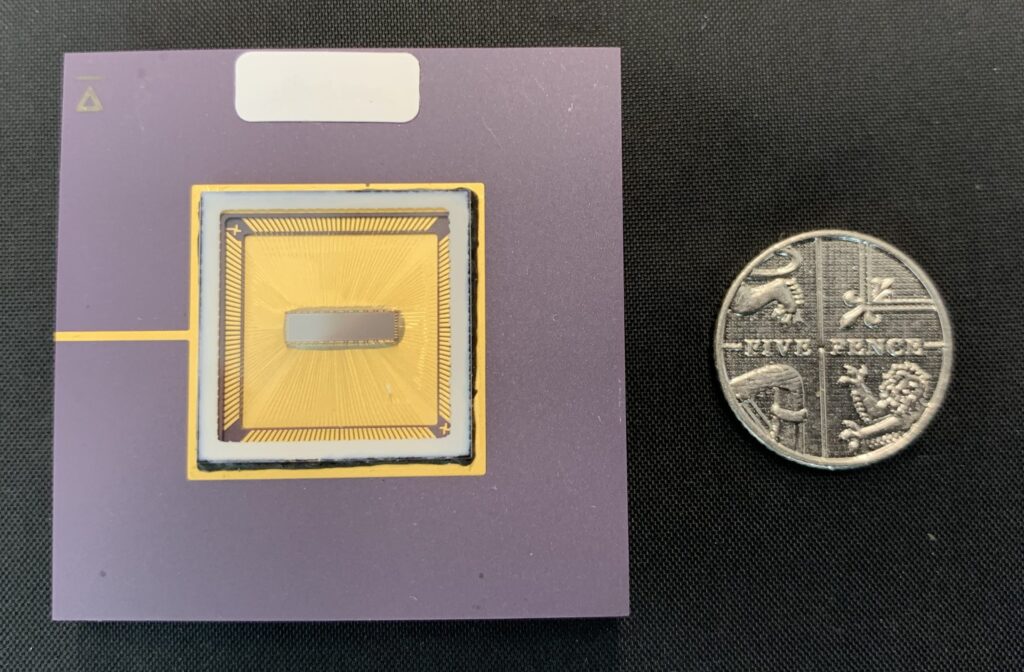
A single‑photon avalanche diode (SPAD) sensor from the University of Edinburgh, with a five pence coin for scale.
“We are thrilled to work with such an accomplished consortium of partners providing a path to solving complex real-world problems. The new 1D array family of sensors Photon Force is developing for this project will enable formerly unattainable standards of sub-sea vision as well as opening up other diverse applications.” – Richard Walker, CEO, Photon Force
Back in 2021, we set ourselves the target of making Sonardyne carbon neutral by the end of 2025, covering all direct and indirect emissions including those associated with manufacturing as well as supply chain activities from all our UK sites and operations. There is no better time than now to update you on some of the fantastic work the Sonardyne team has achieved.
So far, we haven’t said much about how that journey has been going so I thought it would be good to give you, our stakeholders, an update on progress so far… We do want to stand out from the noise of targets, it’s really not just about creating climate targets, we also must take climate action. But that action, if we are to be sustainable as a business, generating value for all our stakeholders, must be a planned and considered sequence of change, executed as quickly as we can.
If you come and visit us today, the most visible signs of our drive for sustainability are 1,300 solar panels on the roofs at Blackbushe Business Park. But there are many not-so-visible improvements that have been made in how we go about our business. Our lighting has been upgraded to LED throughout and we’ve installed a site-wide building management system to intelligently control our energy usage, to name but two. Our final investment in 2023 was in voltage stabilisation equipment, which stabilises the power supply into our buildings, ensuring electrical plant runs at peak efficiency, thus reducing consumption and emissions.
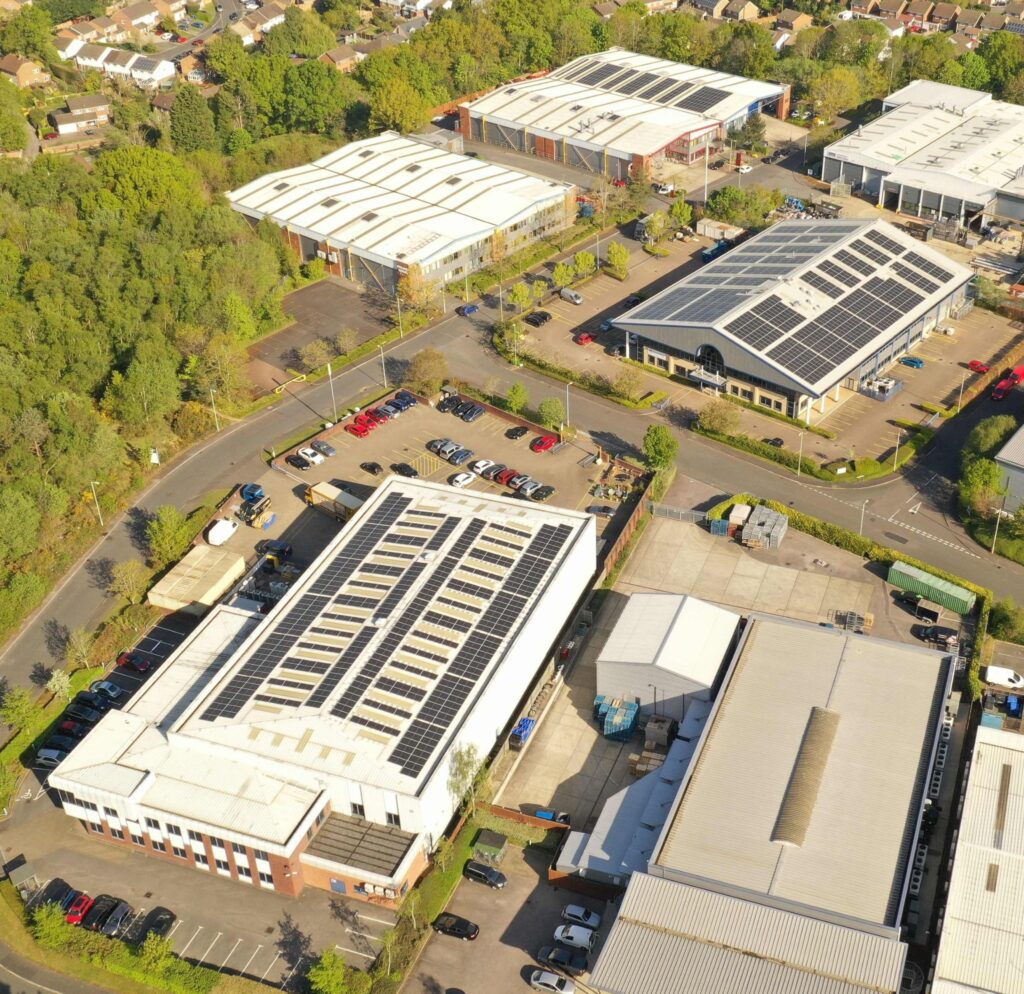
Our three buildings at Blackbushe Business Park are topped by 1,300 solar panels, but our drive to become carbon neutral by 2025 extends far beyond solar power.
In 2024, we will eliminate the last gas-based heating with a major heating and ventilation upgrade in Ocean House. This will mean that all our buildings on the Blackbushe site will be heated by air-source heat pumps. Doing the right thing and committing to it properly has also had real business benefits, beyond saving 120 tonnes of carbon a year, we have also saved in the order of 30% on our energy costs.
At the same time, our energy and finance teams have been diligently working through the three ‘scopes’ of emissions as defined by the Greenhouse Gas Protocol and now have a systematic calculation of our emissions for all applicable scopes and sub-categories. Methodologies and calculation processes have been developed and refined to enable this very complex activity to be considerably less challenging going forward. Our calculations determined that scope 3 emissions (indirect emissions from upstream and downstream activities), particularly in the purchased goods and services category, accounted for by far the most emissions generated by the company (circa 10,000 tonnes of carbon dioxide equivalent in 2023), which must be eliminated or offset. This work has provided us with a very solid foundation from which to plan our next steps in further reducing our emissions.
We can’t eliminate all our emissions, so that raises a series of tricky questions of how to go about offsetting. Who do we trust to offset our emissions for us? What is a good scheme or a bad scheme? Where should we offset? We spent quite a bit of time looking at partners to work with, and in 2023 we made our first foray into offsetting with Carbon Neutral Britain. We were impressed with their approach to supporting projects regulated through the Verra – Verified Carbon Standard, the Gold Standard – Voluntary Emission Reductions and the United Nations – Certified Emission Reductions programmes. As the three largest, and most regulated carbon offsetting standards used globally by businesses, this ensures the measurements and tonnes of CO₂ equivalent offset are as accurate and verified as we can achieve. It will certainly be interesting to see how this part of the carbon economy develops.
In 2024, we will be looking into our supply chain in more detail to further reduce our emissions. We will also be embedding sustainability more deeply into our business processes: from considering how staff travel, where we buy materials, through the operation of our buildings, to the purchase of new capital plant.
Finally, to give all our stakeholders confidence, we will also start work this year on taking the next step in really proving what we are doing. This means a formal independent audit against a globally recognised standard. Whilst we were originally planning to work to PAS 2060, 2023 has seen the publication of ISO14068 ‘Climate change management – Transition to net zero’ which builds on and will replace PAS2060. We will aim for this audit in 2025.
It’s a journey, and we are making real progress. As such, I’m confident that, as Sonardyne continues to grow, we are also taking action to ensure our carbon intensity is reducing with every passing year.
I’ll check in with you again later in the year and perhaps look beyond the triple bottom line of people, planet and profit and look to consider resilience in relation to sustainability. The combination of my hobby of restoring a hazel coppice and relating some current thinking on the very slow business of woodland management curiously has insights for running a fast-paced technology business.
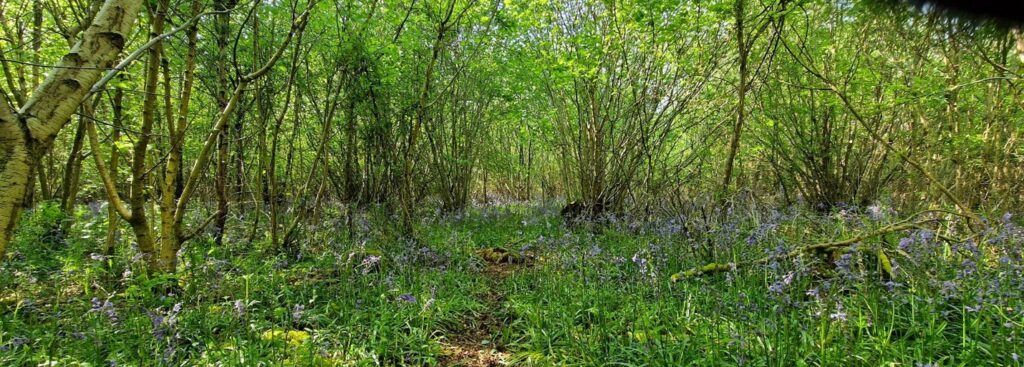
Uncrewed surface vehicles are fast becoming a powerful tool in offshore operations across the defence, energy and science sectors.
Marine Robotics Business Development Manager Aidan Thorn explains how using our Ranger 2 family of USBL transceivers with your uncrewed surface vehicles (USVs) enables truly remote operations when tracking, positioning and communicating with unmanned underwater vehicles (UUVs) or gathering data from seabed deployed sensors – and then lets our customers explain how they use theirs.
USVs really add value to operations when used as a force-multiplier for traditional shipborne operations, allowing the ship to continue with more complex work or when operations are entirely remote from ships and infrastructure. Whether it is for mine countermeasures, autonomous data collection or offshore wind farm site characterisation, they’re a valuable, lower cost, lower carbon footprint and lower logistics platform.
One of these operations is the deployment of USVs as a navigational and communications gateway for UUVs. Equipping a USV with a Ranger 2 USBL provides the UUVs, whether working singularly or as a squad, not just with position and tracking updates but also the ability to communicate data back to the USV and on to the operator
We’ve seen our USBL systems deployed on a variety of USVs for customers needing to position and communicate with a UUV, or a number of UUVs, for their applications. Fugro’s Blue Essence USVs have utilised our Mini-Ranger 2 system for tracking an ROV on remote ops when inspecting gas pipelines in Australia.
The University of New Hampshire’s DriX USV also has a Mini-Ranger 2 that has been used for tracking, positioning and communications with two UUVs at a time, so that the underwater vehicles could be sent commands remotely whilst on mission without the need to surface.
And we’re not just limited to one or two UUVs. As part of an Innovate UK funded project, Squads of Autonomous Robots (SOAR) trials have taken place using Sonardyne’s USV, Decibel, fitted with a Ranger 2 USBL acting as a communications gateway for a squad of ecoSUB autonomous underwater vehicles.
But our USBL offering is not just about robot-to-robot operations. An increasing numbers of operators are using the Mini-Ranger 2, coupled with our HPT 3000 USBL transceivers, on their USVs for over the horizon data harvesting. Traditionally getting data back from seabed deployed sensors has involved recovery of the sensors or communicating with them acoustically via a shipborne system.
This is a very costly and carbon intensive method of gathering data. Fitting the HPT 3000 to a USV means that over-the-horizon operations suddenly become more cost effective, more reliable and less risky. This has been demonstrated by our work with XOCEAN at the Norske Shell operated Ormen Lange gas site and, in the Rockall Trough where the SAMS AutoNaut collected data from a seabed AZA.
Most of the examples given above feature our Mini-Ranger 2, as it is the USBL of choice for a variety of USV operations, but the technology is available in sizes to suit almost any requirement. Available in standard, mini or micro variations, the Ranger 2 USBL transceivers can support a range of marine robotic operations. Let’s take a quick look at the products before letting the customers who use them do the talking…
Micro-Ranger 2 USBL
Portable and quick to set up, Micro-Ranger 2 is perfect for your simple USBL tasks such as tracking divers, an ROV or micro AUV. It is a great introduction to USBL operations and its compact size means it can be fitted to a wide range of vessels or used in harbour / pontoon testing. Despite its smaller stature, it can communicate with the same subsea beacons as its larger family members.
Mini-Ranger 2 USBL
Mini-Ranger 2 is our mid-level USBL target tracking system. Its combination of size and performance means that it can be used on USVs to support data harvesting from seabed-deployed instruments or to communicate with underwater assets such as AUVs. Need to track targets further, simultaneously, and with survey-quality precision? Mini-Ranger 2 delivers on both performance and price.
Ranger 2 Standard USBL
Our most capable tracking and DP reference USBL, it is installed on a global fleet of vessels. It can track everything, in any depth, from any vessel. Able to track a towfish, position an ROV, dynamically position your vessel, communicate with an AUV – or do all of this simultaneously – it’s anything but standard.
Further details for the entire Ranger 2 family can be found on our product pages.
The best examples of the Ranger 2 family and HPT 3000’s uses come from our customers. Here’s what a few of them have to say about how our products have helped their autonomous operations.
Oliver Harris, Senior Operations Manager, XOCEAN: “XOCEAN utilise Sonardyne’s advanced seabed monitoring technologies during offshore survey projects. Our team has witnessed firsthand the value that the HPT 3000 brings to our data collection toolkit, enabling us to gather accurate and reliable subsea positioning data efficiently. Additionally, we have integrated Sonardyne’s HPT 3000 onto our USVs for towed Sidescan and Magnetometer surveys, delivering top-notch subsea positioning data to our clients on various offshore wind projects. We continue to grow our data collection offering, having procured several Sonardyne USBL transceivers to deliver this.”
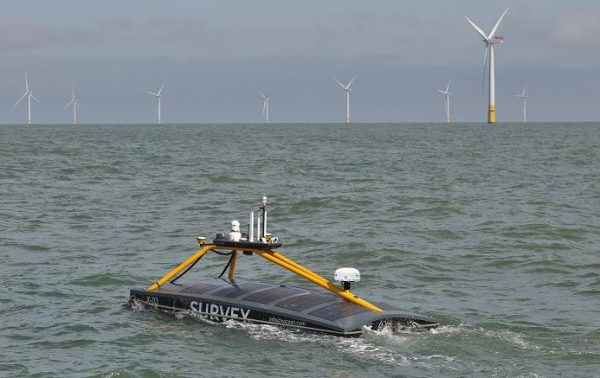
Matt Lussu, Principal Hydrographic Surveyor, Fugro: “We couldn’t be happier with how the Mini-Ranger 2 has performed in ROV tracking from both our Blue Essence USV, Fugro Maali and Fugro Kwilena. We first deployed the USV Fugro Maali with its Mini Ranger USBL system for a client in 2021 on an asset integrity inspection project. Since then, Fugro Australia have taken delivery of our second USV, also equipped with a Mini Ranger 2 system, and have continued to see consistent and reliable performance on commercial programmes for various clients over the past 12 months.”
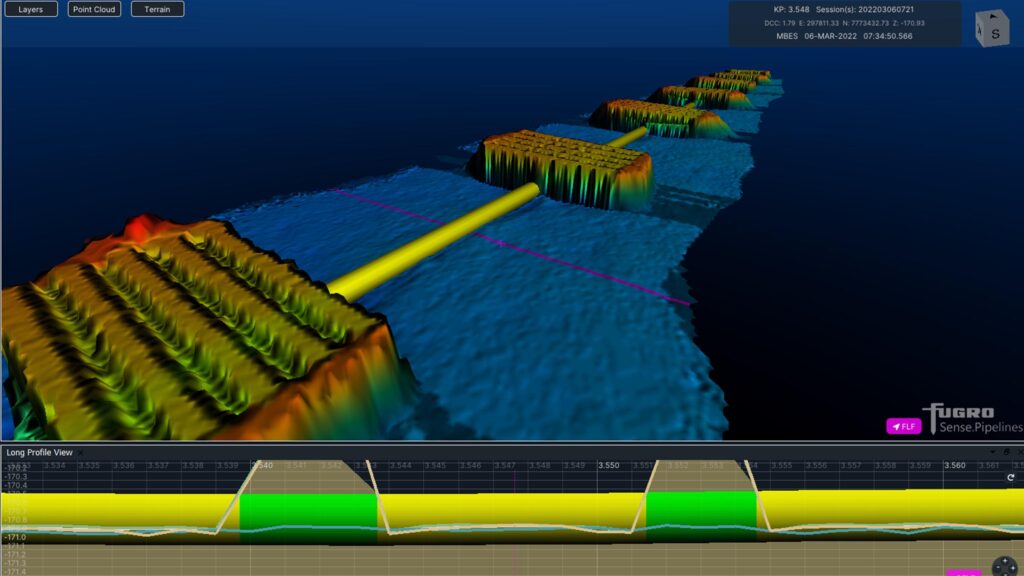
Roland Arsenault, Autonomous Systems Software Engineer, University of New Hampshire: “Having a communications gateway between the DriX USV and the AUVs adds real value to our operations. The Sonardyne USBL system enabled DriX to direct the Mesobot AUV to sample a layer of interest within the water rather than just have it travel to the area and sample blind. The collaboration with Sonardyne to develop specific ROS drivers for our operations ensuring all robotic platforms can talk to each other through the Mini-Ranger 2 USBL has meant true heterogenous operations.”
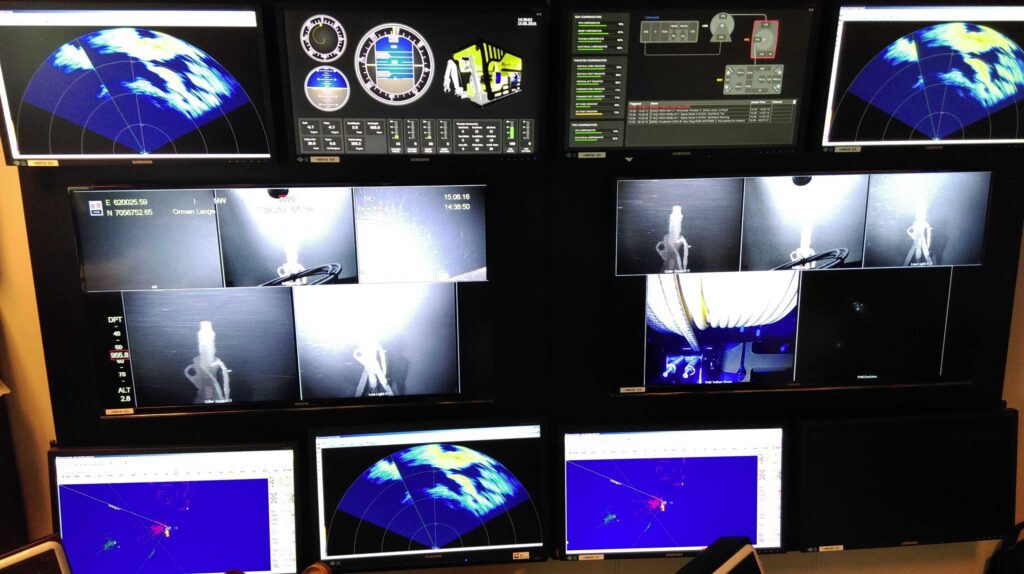
Iain Vincent, Director, ecoSUB Robotics Ltd: “When we first developed the ecoSUB AUV the original concept was focused on launch and recovery from a USV. Through the Innovate UK funded Squads of Adaptive Robots project, we’ve integrated Sonardyne’s AvTrak 6 Nano modems into our AUVs and demonstrated the ability to track and communicate with them through Sonardyne’s Ranger 2 USBL onboard a USV, as well as being able to communicate with other AUVs within a squad. Having this ability really strengthens the flexibility of AUV operations, as being able to communicate between different robotic platforms means that each platform can perform its role and hand off to other platforms to perform theirs.”
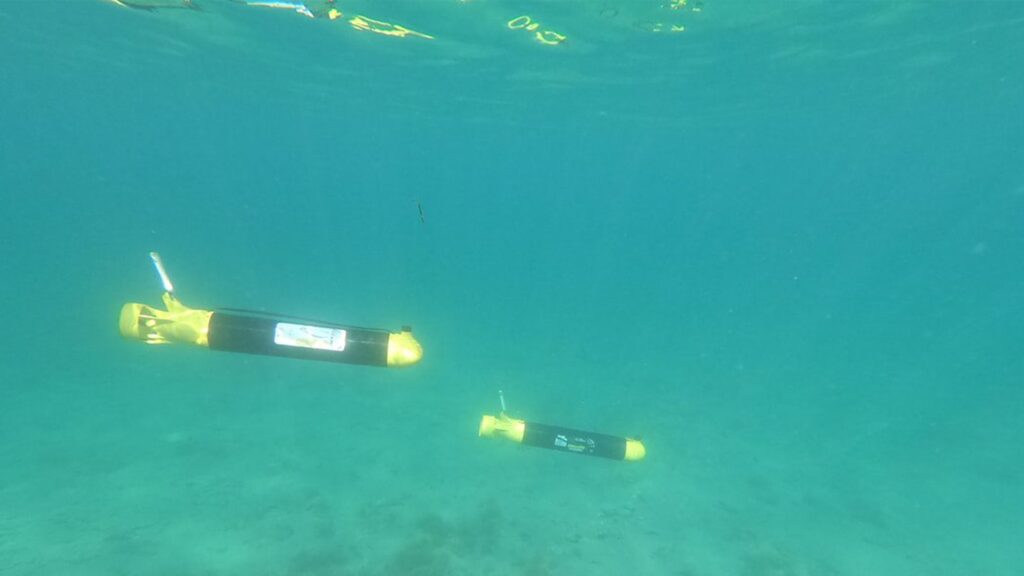
Mike Poole, Director, AutoNaut: “Using a wave propelled AutoNaut USV, equipped with a Sonardyne Mini-Ranger 2 we achieved the first example of through-water communications of ocean climate research data to an autonomous vehicle, and instant transmission of data to shore. AutoNauts are well suited to long endurance missions in the open ocean, meaning that they can be truly remote vessels. Having the acoustic data gathering capability provided by Sonardyne’s HPT instrument has enabled us to gather zero carbon data for our customers in what is a practical and positive response to climate change.”
If you want to know how our Ranger 2 family could support your underwater robotics, drop us a line. We’ll be happy to help.
It’s National Apprenticeship Week in the UK, so we’re celebrating our amazing apprentices and looking at why they chose this route with Sonardyne.
We have apprentices in several departments throughout the company and our current cohort are studying at a range of levels up to gaining a degree, with lots of opportunities for further progression. Let’s see what some of them have to say about their experiences:
Jacob Coles – 20, HNC/D Engineering Manufacturing Technician Apprentice. Jacob has been with Sonardyne since 2021 on his four-year apprenticeship. “My apprenticeship has been ideal for getting used to a work environment. It’s great having the chance to learn hands-on, at the same level as your workmates, rather than being talked at in a classroom.”
Nia Rogers – 19, Level 4 HNC Mechanical Engineering. Nia joined Sonardyne’s repair department as a Manufacturing Apprentice in 2022. “My apprenticeship has been a great way to get hands-on experience while learning and means I can put the theory I learn on my college days into practice straight away. It’s also great that I can learn and earn at the same time!”
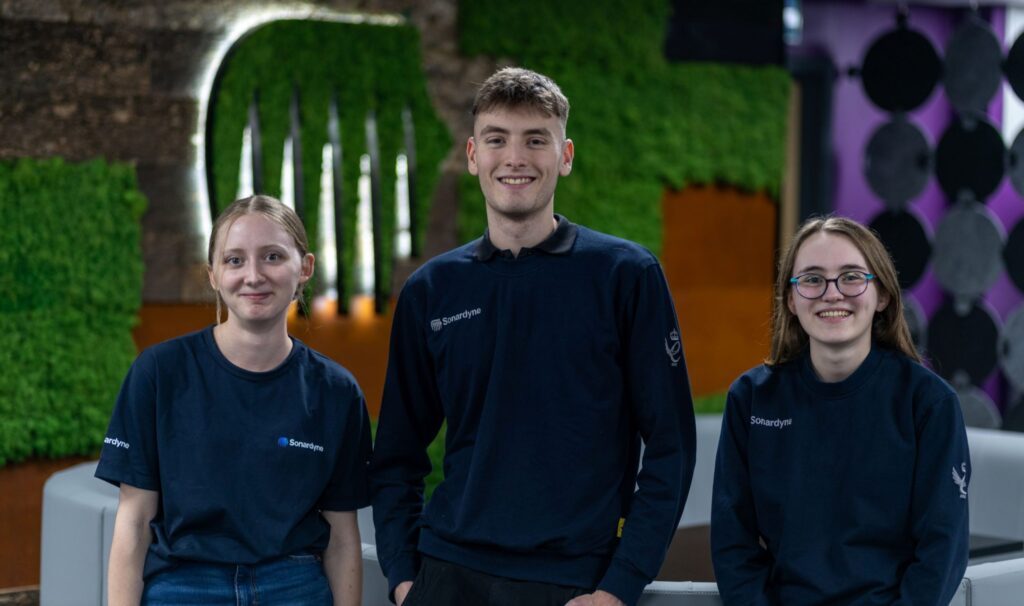
Sophie, Jacob and Nia.
Sophie Palmer – 18, Digital Marketing Apprentice. Sophie joined Sonardyne’s marketing team in 2023 on a three-year degree apprenticeship with London South Bank University. “I chose to do a degree apprenticeship over going to university because of the hands-on work experience I would get while simultaneously studying for a degree. I have been well supported in every stage of my apprenticeship journey so far and I’m enjoying the diversity of the role I’m in.”
Claire Bennett from Sonardyne’s HR department, comments; “As well as offering them real hands-on learning experiences, having apprentices across the business gives us the opportunity to ‘home-grow’ talent and foster a younger outlook within the company.”
Apprenticeships are a real ‘win-win’ for all involved and we look forward to supporting more of them in starting their careers in future.
Leading Taiwanese offshore geophysical and geotechnical investigation company PDE Offshore Corporation have upgraded their underwater acoustic positioning system onboard MV Geo Energy to Sonardyne’s Ranger 2 USBL system.
This will further enhance their capability in the exploration of offshore renewable energy (ORE) in Taiwan. Their new geotechnical vessel Geo Power, also equipped with Ranger 2 USBL system is now under conversion work and will join the fleet in mid-2024 which will provide both seabed and downhole cone penetration testing services.
PDE Offshore have been conducting geotechnical and soil investigation in the shallow waters of the Taiwanese Strait since 2017 as the country looks to replace its coal-based energy with cleaner, sustainable alternatives such as offshore wind farms.
Working with most of the world’s leading ORE developers, PDE Offshore wanted to increase their capability. This required a trusted and proven USBL positioning system for their Geo Technical vessel to work in greater water depths and challenging water conditions as their operations expanded.
Having already successfully used Sonardyne’s Mini Ranger 2 for several years, investing in the full Ranger 2 system was a logical choice to provide the reliable dynamic positioning references essential for their operations, whilst also giving the capability for operating in greater depths and more challenging conditions.
Incorporating over 30 years of USBL knowledge, Sonardyne’s Ranger 2 system is anything but standard. It can be used to track anything, in any depth, from any vessel. Track a subsea asset, position or communicate with an underwater vehicle, dynamically position your vessel – or do all of this simultaneously. It can be used for both survey and construction phases of ORE and supports complex tracking scenarios such as structures and vehicles with multiple transponders and multiple remote offsets.
Huang Hsin-chih, President of PDE Offshore, says, “We have been working with Sonardyne since 2017 using their Mini Ranger 2 system. The system is proven, reliable and our engineers are familiar with its operation. It was a simple and logical choice to go ahead and upgrade to the Ranger 2 system to improve our capability to take on greater projects in the region.”
Dan Tan, Regional Sales Manager for Sonardyne in Singapore, says, “Taiwan’s ambitions of becoming a green island means it is fast becoming a leading player offshore wind in Asia Pacific. We’re pleased to be a part this energy transition through PDE Offshore’s continued confidence and investment in our products. We look forward to supporting them in their future operations.”
It’s not often you get all the right people in one room. At the end of last year we managed just that.
Sonardyne held a two-day Seabed Deformation Technical Workshop bringing together some key members of the Sonardyne academic user community in the USA and Canada to share insights, experiences and how our GNSS-A and AZA instruments can be further improved to meet their future needs. These included; Ocean Networks Canada, U.S. Geological Survey (USGS), Georgia Institute of Technology, Woods Hole Oceanographic Institution and the University of Washington, as well as our hosts Scripps Institution of Oceanography in California. As well as providing the stunning backdrop for this event, they furnished instruments for the workshop form the large pool of our equipment that they support this community with.

Scripps Institution of Oceanography
GNSS-A and AZA are two independent technologies that are providing scientists with a ground-breaking new toolset for measuring seabed deformation caused by plate tectonic movements:
- GNSS-A involves accurate (centimetric) global reference framework (principally horizontal) positioning of Fetch transponders on the seabed using an Uncrewed Surface Vehicle (USV).
- AZA is a technique to accurately measure pressure (and thus vertical elevation) of a Fetch transponder. It does this by correcting for the inherent drift of the pressure sensor. This is also being increasingly used by scientists studying ocean circulation, for whom long term pressure measurements are critical.
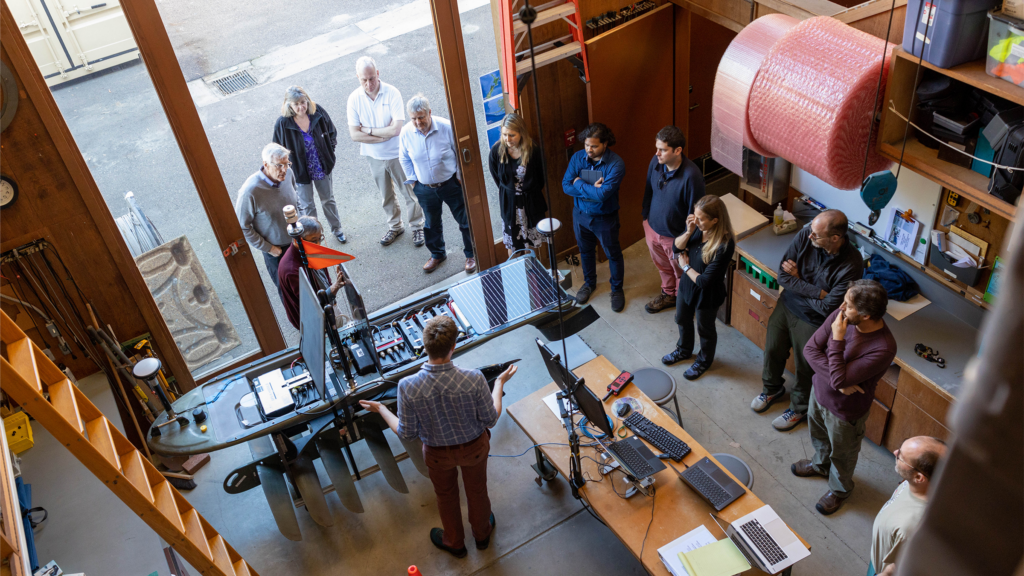
Technical workshop
Each attendee shared their latest research projects and plans with the group, helping the attendees cross pollinate ideas and discuss the challenges they are facing.
The core of the workshop, comprising in-depth technical insights and demonstrations was supplied by Sonardyne’s, Nick Street and Guy Hebden our Queens Award-winning seabed deformation technology from inception and Guy, from our applications group, has first-hand experience of product deployment and managing remote operations. This kind of community interaction is invaluable to ensure that our technology continues to push forward to meet the demanding needs of our scientific users into the future.
The USA and Canada academic sectors provide many collaborative partnerships for us and they are some of the most prolific and high profile users of our products across a wide range of research fields.
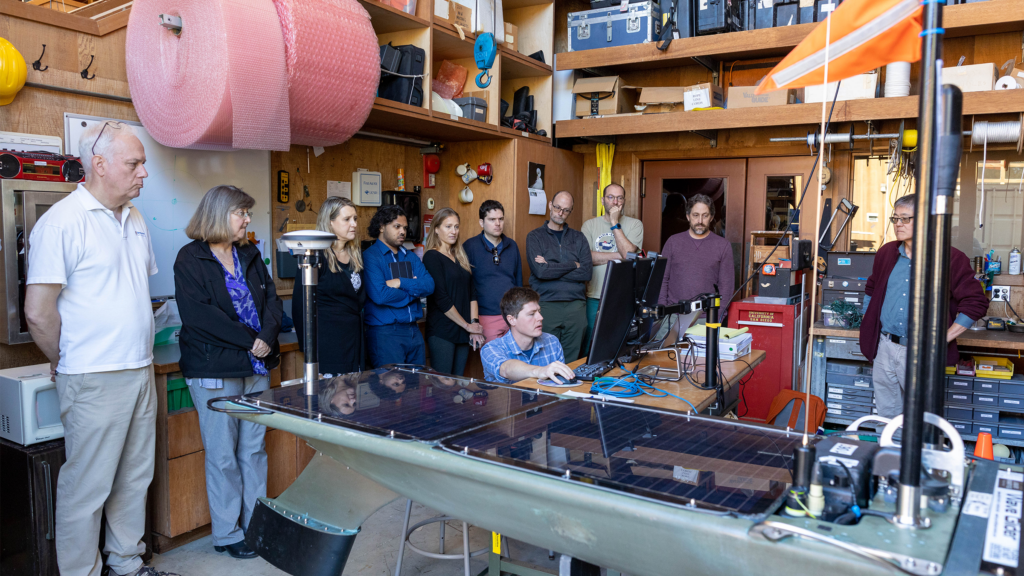
Demonstrations generated lots of discussions
“It’s humbling and very rewarding to see how key our technology is to answer some of the most critical questions about seabed deformation and how this relates to earthquake and tsunami risks. It was no mean feat to pull this collection of world-leading institutions from the US and Canadian academic community together for two days, but the feedback has been so positive that we’re already being asked when we’ll do it again. In fact, it’s encouraging us to look across other parts of our technology portfolio to identify other workshop opportunities that will help foster a collaborative community between us and our academic users.”
Geraint West. Head of Science. Sonardyne International.
The high volume of interactive Q&A and discussion between the attendees provided valuable insight for us into how our products are currently used and how they can be developed to further enhance future research.
As a result, we are investigating the potential for further workshops to foster more user collaboration and communities in future.
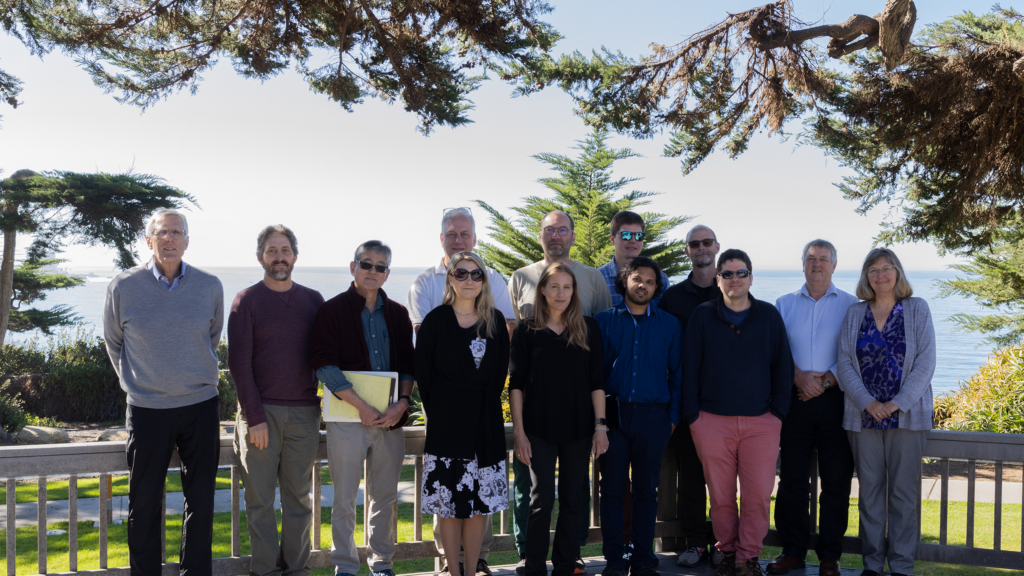
Workshop attendees and Sonardyne staff